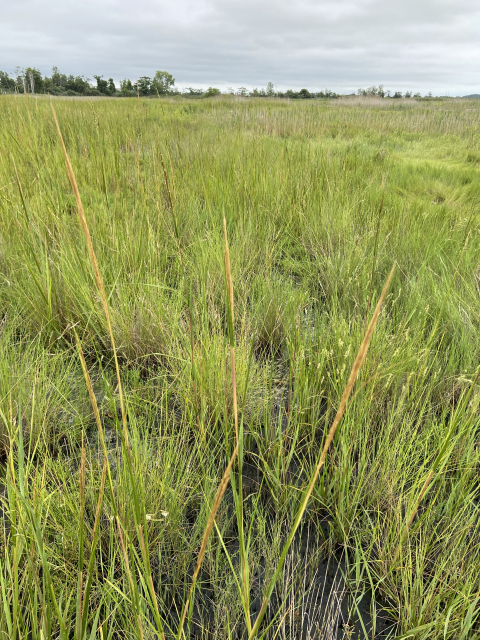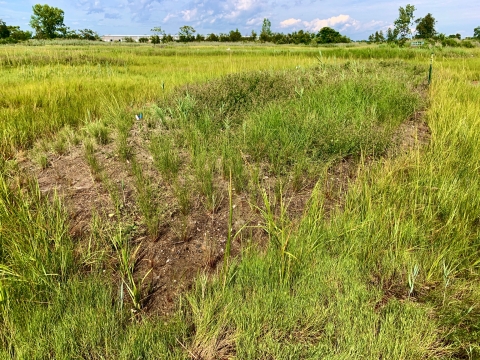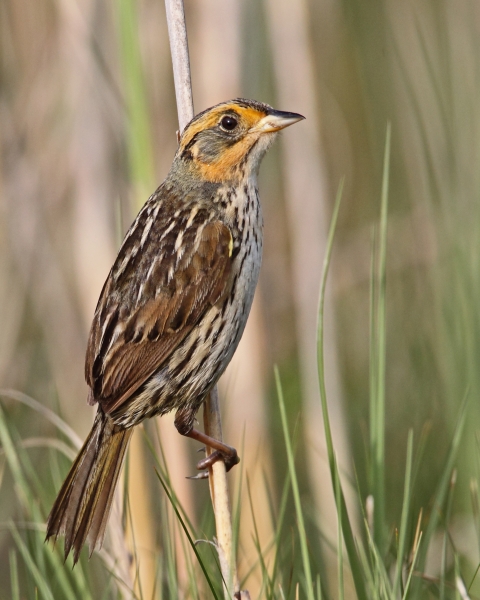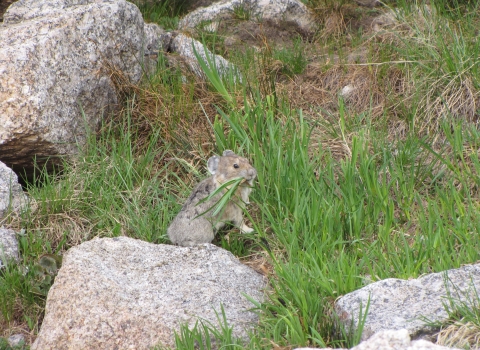They knew they were taking a chance, but the potential pay-off was too great to pass up.
“The Great Meadows Marsh restoration could have jeopardized saltmarsh sparrow and marsh pink at this site,” said Suzanne Paton, supervisory fish and wildlife biologist at the U.S. Fish and Wildlife Service’s Southern New England Coastal Program. “But we knew if it succeeded, the site could attract and support more of these species, and the lessons-learned could be applied at other sites.”
The benefits of a healthy salt marsh salt marsh
Salt marshes are found in tidal areas near the coast, where freshwater mixes with saltwater.
Learn more about salt marsh — coastal resilience, recreation, wildlife habitat — are undeniable. But the act of restoration brings disruption — heavy equipment, changes to terrain and vegetation — that can harm sensitive wildlife and plants already using the site.
That’s why the Service and its partners spent years carefully planning and coordinating their effort to restore a portion of the Great Meadows Marsh on the Connecticut coast — and intend to spend more studying the results.
Long road to recovery
Like many coastal wetlands, Connecticut’s Great Meadows Marsh has a history of being mistreated and neglected. Colonial farmers dug drainage ditches to boost salt marsh-hay production, and more than half of the marsh has been lost to development. Portions no longer function properly due to addition of dredged soils, spread of non-native plants, and sea-level rise.
In 1994, a large area of the marsh became a unit of Stewart B. McKinney National Wildlife Refuge. Then, in 2022, the Service and its partners restored 34 acres of the marsh in hopes of making it a functioning salt marsh again.
Planning for the $4.65-million project took three years and drew upon the expertise and resources of the federal, state and local governments, as well as private groups. Audubon Connecticut, Connecticut Department of Energy and Environmental Protection, National Oceanic and Atmospheric Administration, Town of Stratford and the Service all contributed.
Nearly $1 million came from Natural Resource Damage Assessment and Restoration settlements with General Electric Corporation, Lordship Point Gun Club and Raymark Industries, which were responsible for contamination at three nearby sites. Using settlement money to restore the marsh to benefit fish, wildlife and people helps compensate the community for environmental harm.
A worthwhile wager
Project partners were united in their mission to increase available salt marsh habitat — critical for both wildlife and human health — at Great Meadows. Healthy salt marsh absorbs storm surge and rising seas, protecting people and property. Some animals and plants, like saltmarsh sparrow and marsh pink, rely on these areas as habitat. Saltmarsh sparrow populations have fallen sharply in the last decade due in part to the loss of high-marsh areas where they nest.
Unhealthy salt marshes add to climate change climate change
Climate change includes both global warming driven by human-induced emissions of greenhouse gases and the resulting large-scale shifts in weather patterns. Though there have been previous periods of climatic change, since the mid-20th century humans have had an unprecedented impact on Earth's climate system and caused change on a global scale.
Learn more about climate change by releasing stored carbon dioxide into the atmosphere. And NASA estimates that, every hour, the world loses an area of salt marsh the size of two soccer fields to storms, development and sea-level rise.
Managers recognized the particular value of Great Meadows Marsh as a test site for new restoration techniques. Since it was degraded and had only a small population of nesting saltmarsh sparrows in one small area, potential harm to the species was minimal. Large-scale change could jeopardize the sparrows using the site, but if restoration succeeded, the marsh would attract more of the birds in the long run. The experience gained could be applied at other sites.
Beginning in fall 2021 and continuing through summer 2022, crews cleared invasive plants, removed excess soil, reshaped the surface, built new channels for seawater to move in and out as it should, and planted native vegetation.
Managers experimented with building mounds of soil — called hummocks — rather than causing broader disruption by raising overall elevation. The hummocks were planted with salt meadow cordgrass, soft rush and spike grass to offer the high-marsh habitat the sparrows and other marsh-nesting birds need.
The marsh took it from there. A year on, signs of recovery and regeneration were everywhere. The marsh is more resilient to sea-level rise and climate change and has renewed potential to support rare plants and animals for years to come.
Unflappable birds
The next spring, saltmarsh sparrows returned, despite the marsh’s altered state. Although plant cover on the hummocks was not yet thick enough for nesting, the birds foraged for insects and spiders on the new mounds.
Most importantly, the sparrows’ overall nesting success at the site was relatively unchanged. Other marsh-nesting birds, including willets and clapper rails, nested on the new hummocks.
“The site looked a lot different when the sparrows came back in the spring, but they returned,” said Paton. “We implemented large-scale change, and it didn’t displace our species of concern, which was a huge relief. We now hope, once plants on the hummocks — and across the restoration site — mature and spread, the sparrows will move into the new nesting habitat and successfully produce young that will return to nest for generations to come.”
Surprise seeds
While the sparrows tolerated the disruption, another species thrived on it.
Great Meadows Marsh is home to the only remaining Connecticut population of marsh pink, an annual plant considered endangered in Connecticut. To increase numbers, crews removed invasive common reed and planted marsh pink seedlings in spring 2022. Those plants died, but others sprouted from seeds existing in the soil.
Belying its delicate appearance, marsh pink craves disturbance. Restoration activities — heavy equipment moving soil, invasive common reed pulled from the ground — likely brought buried seeds closer to the surface, where they found the growing conditions they needed. In fact, seedlings appeared in unexpected places, a sign that seeds are widespread on the site. Abundant rainfall over the summer no doubt gave them a boost.
“Marsh pink came up in places where we didn’t expect it to,” said Molly Sperduto, Natural Resource Damage Assessment and Restoration program supervisor in our New England Field Office.
Although most of the soil-moving is complete, managers may continue disturbing the surface by hand to promote marsh pink growth. They also planted more seedlings in 2023 and collected seeds from those plants to grow in a greenhouse for the future.
Plantings of other native grasses and shrubs took off, supplemented by seeds in the soil from pre-restoration. In some spots, growth is so uniform it’s hard to tell the marsh was disturbed.
Putting out the welcome mat
The reinvigorated marsh is visible and accessible to all, drawing people as well as wildlife. A refurbished trail and two new viewing platforms attract hikers and birdwatchers. Wading birds like great egrets and snowy egrets form patches of white as they feed in the shallows.
"In the past, you could be there most of the day and not see a visitor,” said McKinney Refuge Manager Rick Potvin. “Since the restoration, I haven’t been onsite without seeing a birder.”
Thanks to the restoration, there are fewer areas of standing water — AKA mosquito nurseries — even during a wet year like 2022. After decades of fending off the pests, refuge visitors and neighbors appreciate the change.
“The site went from unwelcoming to welcoming,” said Potvin. “What’s good for wildlife is good for people.”
The community has a new sense of ownership in the marsh. More than 150 volunteers and a dozen paid high school students planted native species on the reshaped landscape. Employees at the Amazon warehouse across the street spend their lunchbreaks taking in the view and picking up litter at the marsh.
Just the beginning
Even with all this good news, the site is a work in progress. Habitat restoration is not a “one and done” endeavor.
“You have to be committed to continuing to work on the landscape and making it better,” said Drew Major, fish and wildlife biologist at our New England Field Office. “You can’t restore and just leave.”
Knowing this, partners included funding for adaptive management in the project budget. This innovative move allows ongoing monitoring to detect and address any undesirable outcomes. If — more like when — invasive common reed storms back, they’ll control it. Where heavy equipment packed the ground, causing plants to struggle, they’ll apply a new layer of soil. Where water pools on the marsh’s surface, they may dig narrow drainage ditches called runnels. They’ll continue to adjust and refine, in pursuit of a healthy Great Meadows Marsh.
Meanwhile, the contractor that managed the construction phase of the restoration, including building the hummocks, has applied the experience to other salt marsh restorations in New England.
Due to their careful coordination, preparation and follow-up, the Service and its partners are confident the Great Meadows Marsh restoration will be successful, benefiting wildlife, plants, the community and beyond for years to come. A little risk can go a long way.







